Siemens 2005 line or the 75-series
And again Siemens lost the majority of its presentations both
telling about their products and description of marketing initiatives
till the end of 2005 (all the descriptions and some presentations
are available on Allsiemens.ru)
before the official press release. Some of the devices described
lower will be introduced at CeBIT and some later. So, let's see
what's going to happen tomorrow and try to analyze a new product
line.

Similarly to other manufacturers Siemens decided on offering non-camera
variants of its standard devices. In particular, the S65 without
a camera was named the SP65. An evident underline of the old platform
shows the company doesn't plan to position the model highly. That
is an intermediate solution between Siemens
S65 и CX70
and price positioning will take place in this segment. Besides the
absence of a camera, software was changed slightly. Some people
say AAC and MP3 support are possible to appear that is unlikely
due to marketing reasons. MP3 as a call signal is the main trump
of the company. Wholesale price for Siemens SP65 is 175 Euro or
about 230 USD that is really expensive. The same collision happens
- the price pushes customers away from Siemens
SK65. Considering the company's policy we can forecast the fall
of the SP65 price and sales decrease on the threshold of Siemens
CX75 launch. Such models as Nokia 6021 and Sony
Ericsson K700 are taken as rivals. The only thing to add is
the SP65 won't be interesting considering its price and the segments
saturation.
I'd like to note, mp3 support is not provided yet, the function
is announced, but working examples are still absent. Considering
long life of the 65 series and possibilities of mp3 realization
we can surely expect the function to appear.
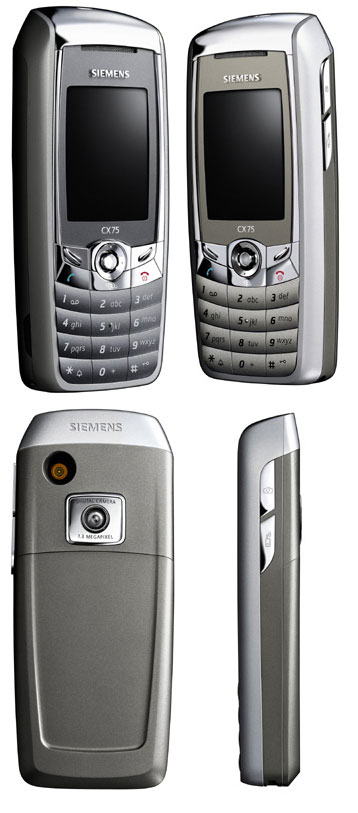

Siemens
CX75. Live photos from CeBIT 2005
Siemens
CX75. Official photos
Specification
Siemens CX75
The company plans to introduce the CX75 in the middle segment,
the model is to become the main one in 250-300 USD segment and fix
its positions even from the start of sales. Later it's planned to
transfer it to 200-250 USD segment and at the moment of leaving
the market (a year after the sales started) the price may reach
110-115 Euro.
The screen controller is different to Siemens
CX65/CX70
and allows showing 262K against 65K colours. But this improvement
did not influence the quality of the picture and really looses to
Sony
Ericsson K700 and Samsung devices. In fact, the improvement
is noticeable inside the company line and still the screen's behaviour
in the sun remains its strength.
Integration with Bluetooth is the second improvement; the technology
has become de-facto mass and available in the middle segment. That
is enough to have a look at Motorola
E398, let alone old offers by SE. It was decided not to refuse
IrDA in the 75th series. The technology is probable to remain in
the company devices for the next 2 years.
Also a 1.3 MP CMOS camera is inherited from Siemens S65, the settings
are similar, in the following report
you can acquaint with the camera quality.
Similar to the S65 the device is equipped with an RS-MMC expansion
slot placed on the bottom. MP3 and AAC support is provided. Speaking
in hardware terms, we can find no differences from S65 and thus
we see using tested equipment in a younger model. The CX 75 shipments
are to start in the beginning of the summer but some markets will
provide with the model even in May 2005. Reasoning from the inner
development cycle the realization of relatively stable software
will be possible only by the beginning of August, September. Two
colour solutions will be available - Titan grey, Sand silver.
Such models as Motorola E398 (in mp3 component), Sony
Ericsson K750i (high functionality and price) compete with the
model. Siemens CX65 may be a success taking intermediate position.
It will appear a bit earlier than the E398 renewal with a megapixel
camera expected only by September. Unfortunately, the CX65 had all
the chances to become a strong offer by Siemens in 2004, but many
software problems prevented it from that. The model often turned
off before the 16th version and was generally hard to use. If the
situation repeats for the 75th line the sales will be lower than
the forecasted ones. The company should pay great attention to the
software stability even at the expense of functionality.
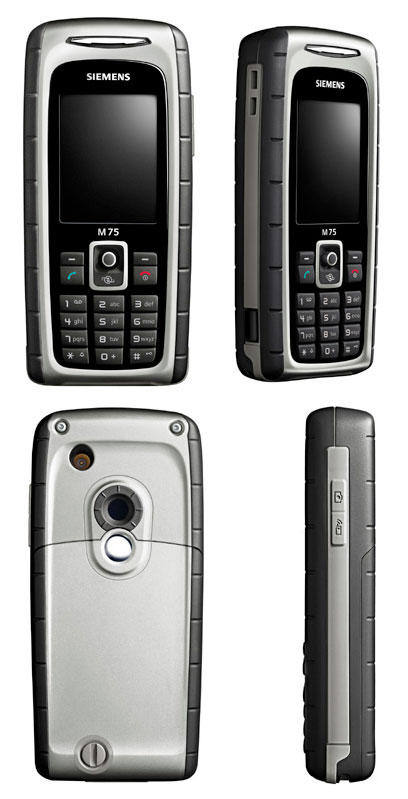
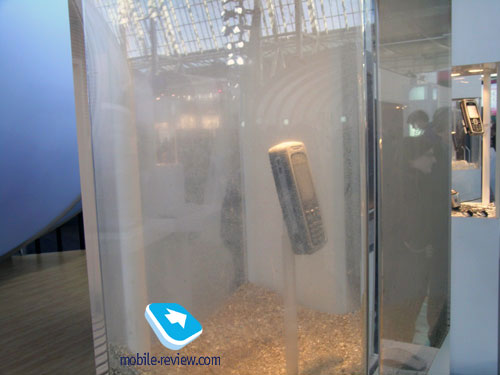
Siemens
M75. Live photos from CeBIT 2005
Siemens
M75. Official photos
Specification
Siemens M75
Similarly to Siemens
CX65/M65
couple the 75th line will provide its paired devices. The M75 differs
from the CX75 only in a protected body. Now it is spray and dustproof.
The model is to appear on the market at the same time with the CX75
or a bit earlier. The price difference will form about 25 Euro.
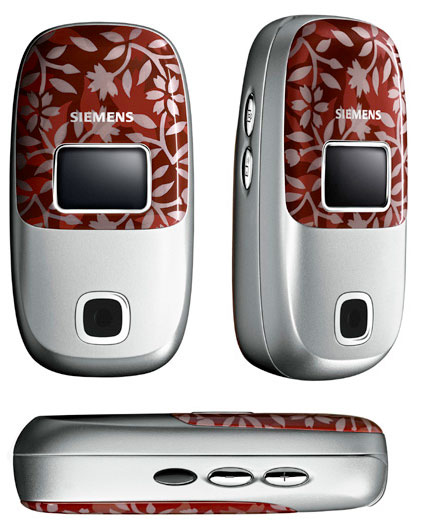
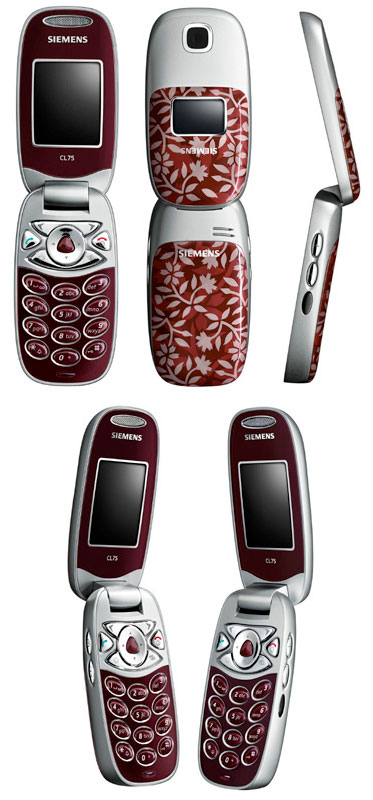
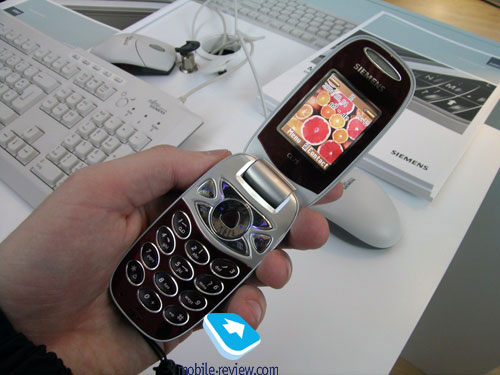
Siemens
CL75. Live photos from CeBIT 2005
Siemens
CL75. Official photos
Specification
Siemens CL75
The company also plans to offer some new models in the clamshell
segment. Siemens CL75 is a device of the season. That is a cheap
women clamshell competing with Samsung and Motorola mainly. A typical
image of a customer is 20-35 year-old one having a low or medium
income. Speaking in functional terms, the device is typical for
the 200-250 USD segment (for the start of sales) and some correction
to the level of 150-200 USD should be expected by the autumn.
The phone is equipped with an integrated VGA camera, there is an
external antenna and an internal 262K TFT screen having the resolution
of 128x160 pixels. An external screen is 65K STN with the resolution
of 96x64 pixels. There is a 780 mAh Li-Ion battery working for 3
hours in the talk mode and up to 220 hours in the standby mode.
The device is of 87x44x23.3 mm size and weights 90 grams. The VGA
camera allows recording video. Standard for the class 11 MB of internal
memory are provided. The presence of a fully-functional IrDA makes
the device interesting. There is 40-tones polyphony (no support
for mp3).
The CL75 shipments are to start in the middle of the summer, in
September the software will be renewed and IM-client with Push to
Talk function will appear (Siemens variant of the function is called
Push and Talk).
Siemens CL75 is in some kind a надстройкой above Siemens
CFX65 without any evident advantages besides the design. The
presence of two colour solutions, targeting on women audience and
standard functionality make the model interesting only to a limited
number of customers. Considering Samsung's pressure, the launch
of a Т500
successor in another style we can say the chances for success are
very low for the CL75. That is a good assortment offer but not a
bestseller.
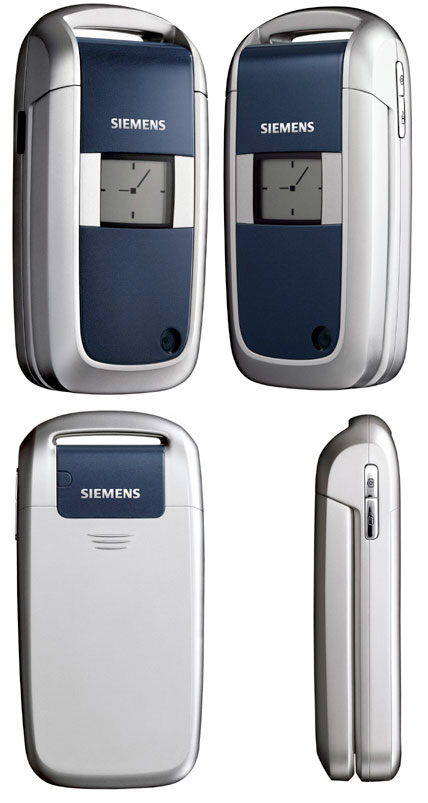

Siemens
CF75. Live photos from CeBIT 2005
Siemens
CF75. Official photos
Specification
Siemens CF75
Siemens CF 75 is to represent low-end products by the company.
The difference from the CF62
is that its inner screen now has the resolution of 128x160 pixels
and shows 65K colours (STN). The external screen is also colour
showing 4096 colours (96x64 pixels). The device interesting in EDGE
support offers 4 MB of integrated memory and a VGA camera. The dimensions
of the phone are 94x47x22 mm, while the weight is 91 grams. Two
colour solutions will be available - Ocean blue, Pearl black. The
model is very probable to become a "folk" clamshell by Siemens for
its low price and IrDA presence. Traditionally such products have
low sales though are interesting for the price/quality ratio. Customers
prefer fashion devices mainly, choosing screen quality and polyphony.
Siemens CF75 with the start price of 175 USD will be launched in
the mid summer. Smooth price correction will make the model interesting
even in September, and thus the price may form 130-135 USD.
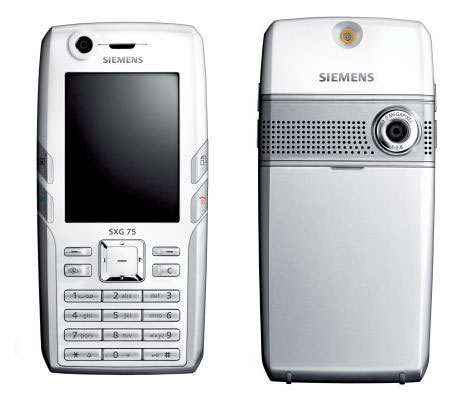
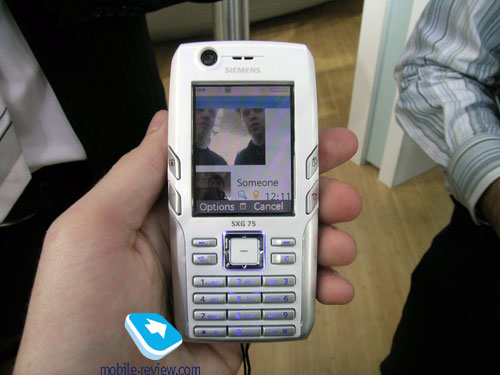
Siemens
SXG75. Live photos from CeBIT 2005
Siemens
SXG75. Official photos
Specification
Siemens SXG75
The SXG75 caused some talks, judging by the index it is to be
a typical smartphone, some kind of continuator of a line represented
only with the SX1
today. The specs seemed to prove the opinion, but then a QVGA screen
showing 262K colours, an integrated GPS receiver that is seldom
to find in smartphones. Memory capacity forms 128 MB and only 64
of them are for user needs, also RS-MMC expansion slot surely point
the device is a smartphone. But I'll suppose the model is only a
3G phone based on a proprietary or a closed version of an operating
system. A frontal camera for video calls has the CIF resolution
and the second camera is CMOS but with the resolution of 2.2 MP.
The target group mainly consists of men aged 20-35 with a medium
or high income. There is an mp3 player and FM-radio integrated.
In principle, considering that the majority of UMTS phones for Siemens
were developed and manufactured by Motorola the SXG75 may be referred
to them.
But, judge yourself. The dimensions of the SXG75 are 111.5x53x20
mm and correspondingly of Motorola
E1120 they form 113x52.8x21.5. The resolutions and colour possibilities
of the screens are similar and that is not actually one more proof,
just an extra hint. Battery capacities are also equal, and that
happens sometimes. In separate, the fact 64 MB are available to
a user in both cases tells about nothing also. In general Siemens
seems to have used a cut version of Motorola E1120 having included
its solutions into the platform, in particular a GPS-receiver, company
software. Differently to the original device camera possibilities
worsened greatly, but IrDA appeared.
Both devices are to appear in the end of 2005, and the price for
Siemens' solution is about 650 USD higher. In general public delight
about this 3G phone are too high, actually no improvements comparing
with Sony Ericsson K750i appeared, and considering UMTS version
of the model will appear in the end of the year no sense in Siemens
SXG75 is seen. Though on the other hand, some brand worshipers may
provide certain sales and operators' contracts. Anyway, only Motorola
will win in that case. I'd note Siemens completely lacks own developments
of 3G phones, thus the company is greatly inferior to other manufacturers.
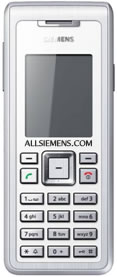
Let's pass to the models that haven't got indexes yet and are
indicated only with code-names. The first device is Mars. That is
a phone designed in a classic form factor being a typical low-end
solution. The 65K TFT screen has the resolution of 128x160 pixels.
There is IrDA but Bluetooth is lacking, memory capacity forms 3MB.
The device is 110x44x12 mm weighting 100 grams. The battery is 820
mAh Li-Ion enough for 5 hours of talks and up to 250 hours in the
standby mode. The polyphony is 40-tones, GPRS class 10. We can't
say Mars is a typically low-end solution since the manufacturer
tries to position the device lower than Nokia 6021 but higher than
Nokia
2600. In Nokia words, that is a renewed 3000 series and for
Siemens that is in some kind a modern copy of Siemens
C62.
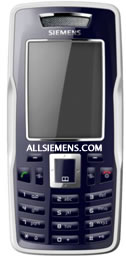
Minos is a renewal for the CX line that will be introduced later
and sales are to start in the autumn 2005. It differs from the CX75
in expanded capacity of integrated memory (up to 20 MB available
to a user), integrated flash, renewed software and another set of
games.
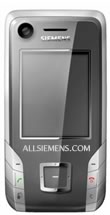
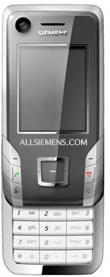
The last model we got information about from the network is the
Wolf4. That is a slider-smartphone with the dimensions of 98x50x23
mm and weighting 89 grams. Traditionally, the GSM trial band device
supports UMTS services. In connection with that the battery is 950
mAh Li-Ion. Work in the standby mode may last for 335 hours and
in the talk one for 4 hours. The only one body colour Titan is provided.
The presence of a 262K TFT screen with the resolution of 176x220
pixels is a peculiarity of the phone. These screens are typical
for Motorola's products and as we have written above UMTS-phones
by Siemens are turned Motorola's phones till today. Considering
some characteristics, screen images and the announced full synchronization
with specific products by Microsoft, Wolf4 is run by Windows Mobile
2003 for Smartphone. If that is right, we can surely say the device
will remain behind similar solutions, the majority of 2005 products
of this class will be equipped with 240x320 pixels screen.
Other characteristics are ordinary. That is 1.3 MP camera, a frontal
CIF camera, expansion slot for RS-MMC cards, 60 MB of integrated
memory. Functionally the phone is a typical Siemens device with
nothing special. The model is to be launched in the end of the 3Q
with the price of 450 Euro.
Short conclusion

Siemens.
Live photos from CeBIT 2005
This information leakage drew great interest to Siemens and a real
wave of discussions. In fact, that all corresponded with the company
marketing, when that's necessary to rouse interest to its new devices.
The Siemens model offer can't be called very strong now, the fact
its product lines aren't united with a common idea is clearly seen.
We now see three product lines not connected in fact. First, they
are typical low-end solutions and classical models by the company.
Second, that is a whole line of fashion clamshells in a middle segment
mainly ODM-models. Third, UMTS devices became a separate branch.
Here everything points out to the start or renewal of collaboration
with Motorola.
The backbone of the future sales are C75, CX75 including M75),
and naturally, all low-end solutions refer to it. A traditional
Siemens S75 will attract attention in a high-end segment. Considering
the functionality of the models described I can suppose Siemens
C75 will have a 128x160 screen, a VGA camera and more than 10 MB
of memory. That is mainly a copy of Sony Ericsson K300 with a comparable
functionality. Siemens S75 will be equipped not only with great
memory (about 20 MB), but also a CMOS camera with high resolution
(2MP). I won't be surprised at an integrated flash in the model.
In all the rest that is a typical copy of Siemens CX75. I'll repeat
that described characteristics of Siemens C75, S75 are my suppositions;
we'll see how right I guessed.
Comparing the models with rival offers we may see they are functionally
saturated but loose to similar solutions by other manufacturers.
Launch dates will be close and that gives no advantage to Siemens.
MP3 support appeared about a year ago and that is not a real technological
break but demands of the times. At first the company tries to compete
with Nokia products and then with other manufacturers. Traditionally
low offers in a fashion segment makes Siemens positions weak against
a background of Samsung and other Korean manufacturers strengthening,
and also new plans by Motorola with slim devices. Increasing Sony
Ericsson's market share makes competition in the middle segment
(C, CX-series) And only in a low-end segment the company keeps its
strong positions, last models by Motorola are evidently less winning
in design than Siemens' ones. Considering that all we can forecast
a hard year for the company and the main task is to achieve the
stability of its phones. Having solved this question the company
will restore its image in the customers' eyes and increase sales.
At that moment 3G models will probably dominate and the company
will have all the opportunities of finding a new partner.
We now have to wait for the official announcements from CeBIT and
the photos may be seen from the first days of the exhibition.
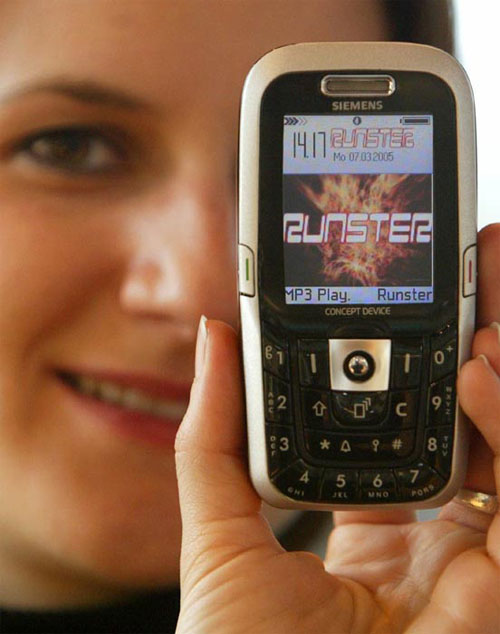
P.S. By the way, that is a concept-design of the smartphone SX1-successor
by Siemens. Experiments with a keypad are still being held.
Eldar Murtazin (eldar@mobile-review.com)
Translated by Maria Mitina (maria.mitina@mobile-review.com)
Published — 11 March 2005
| 
















